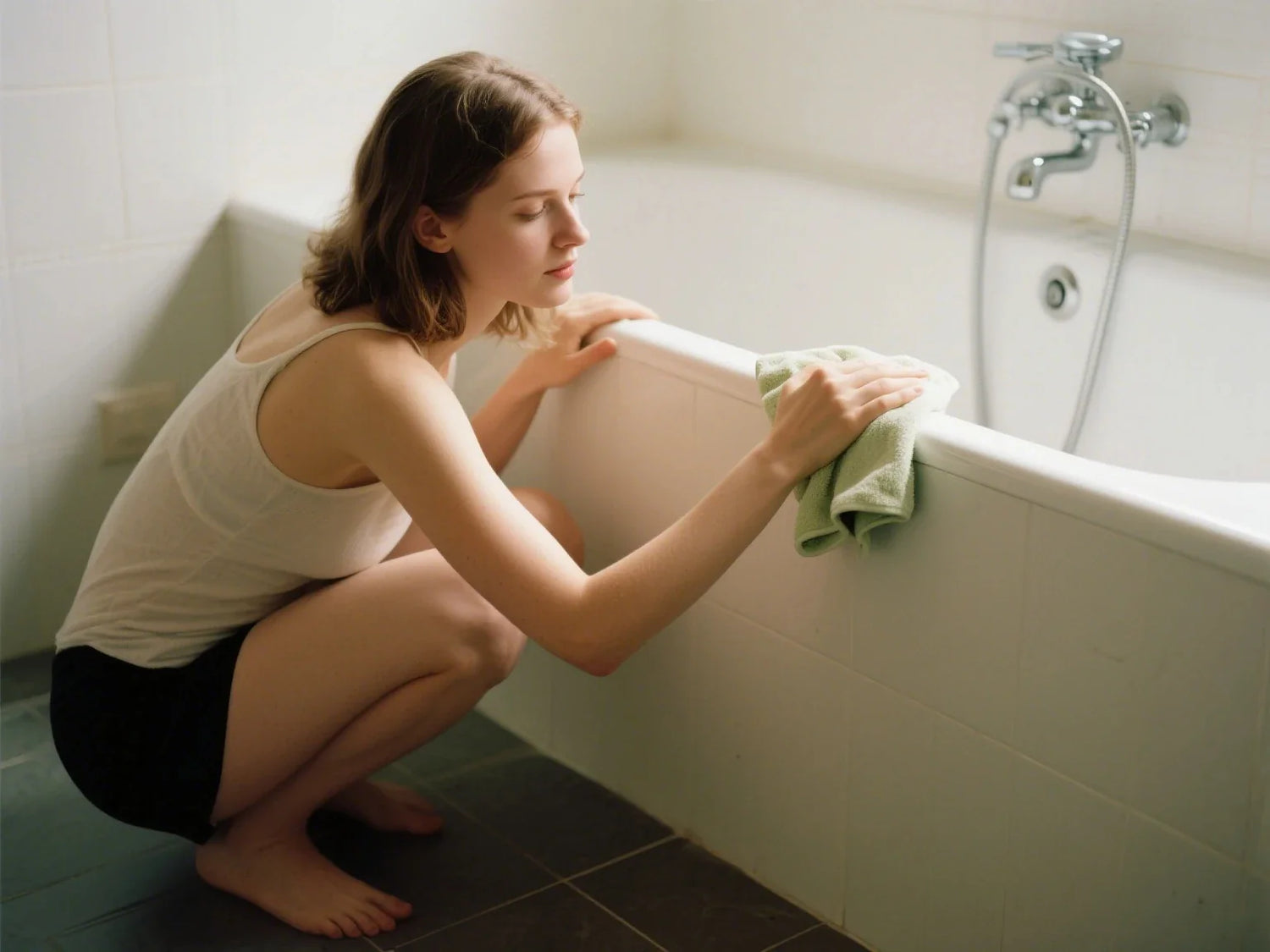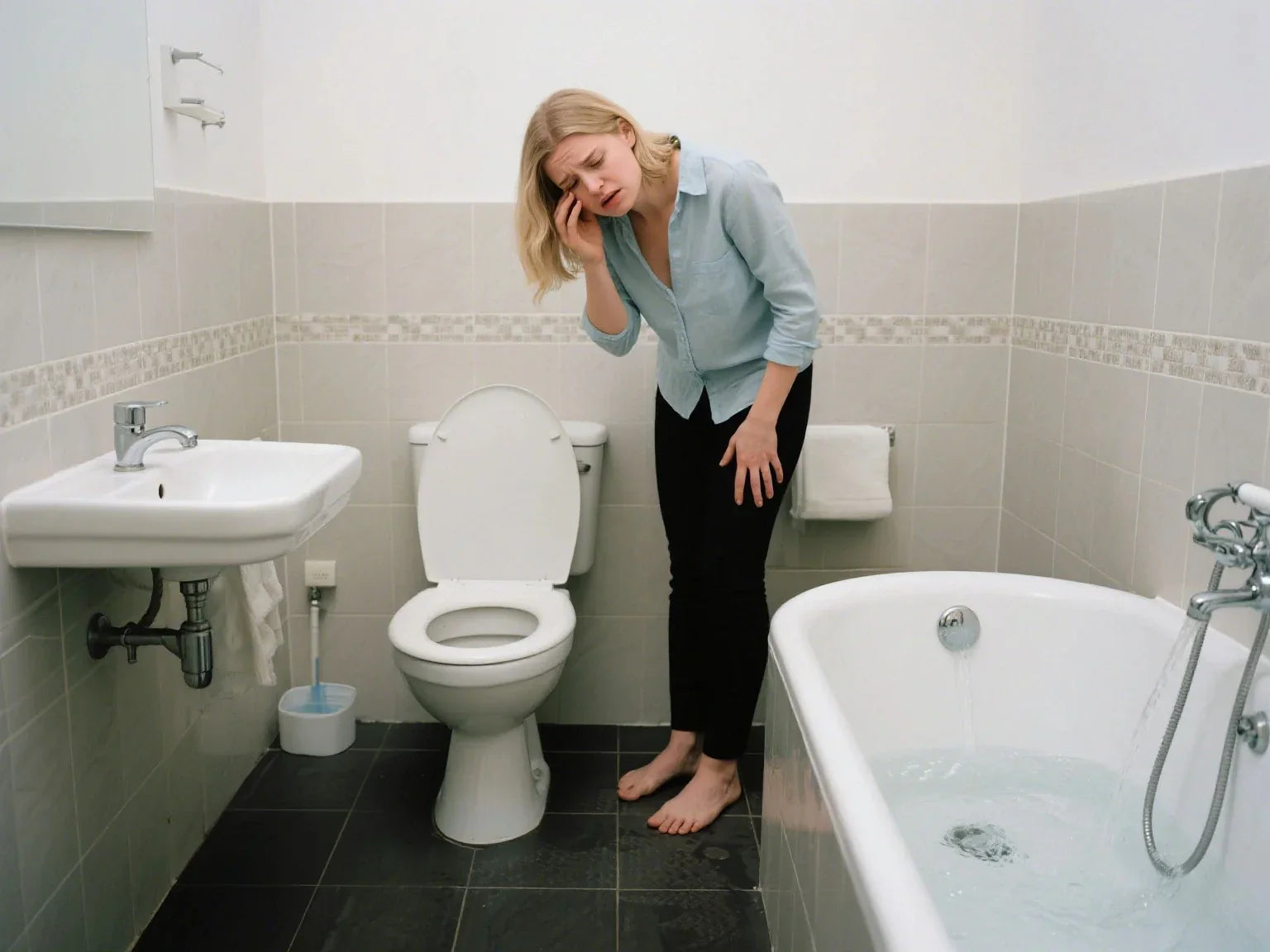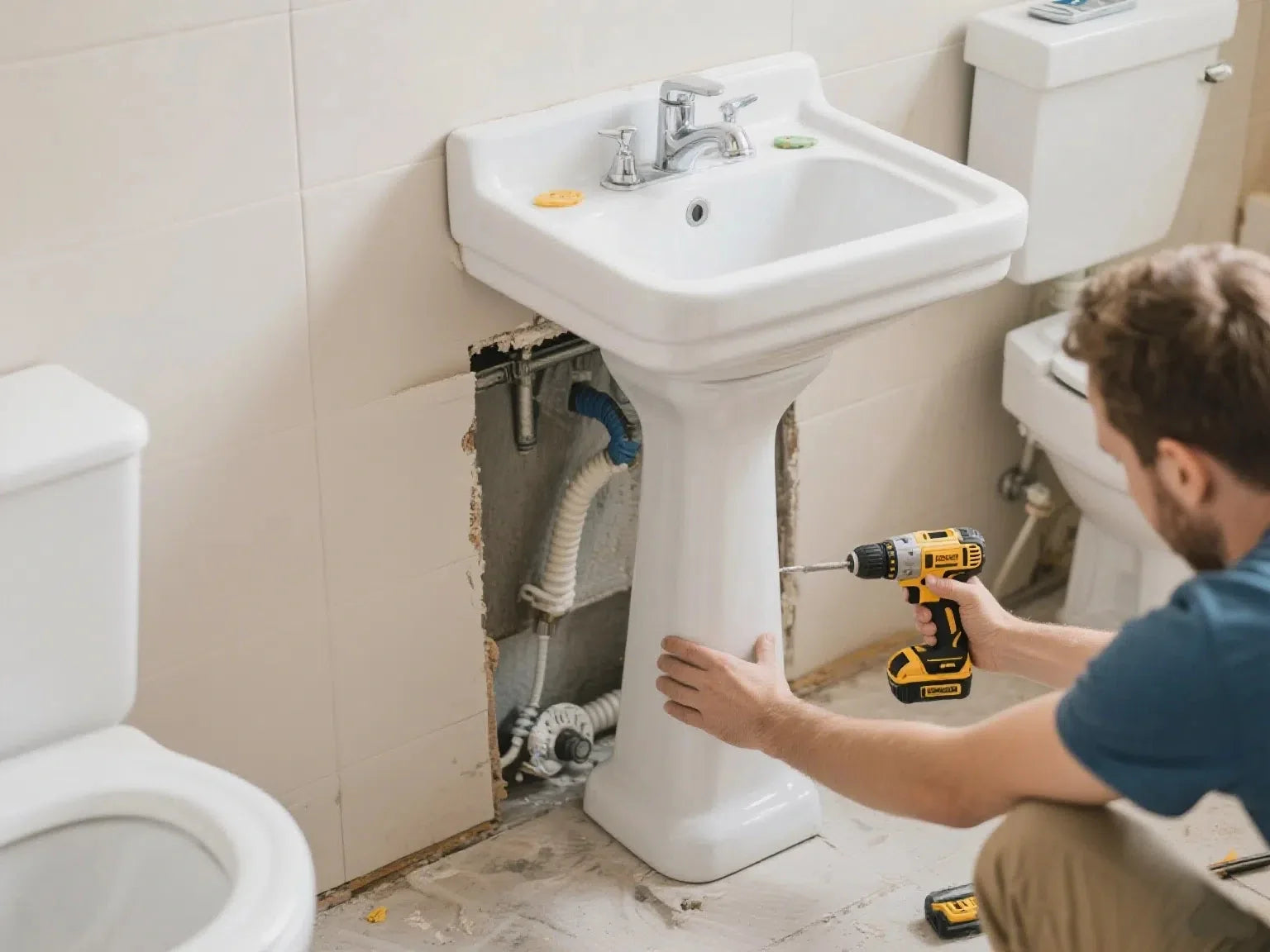Keeping your acrylic tub spotless and damage-free starts with the right cleaning routine. If you’re wondering how to clean acrylic tub safely, this guide covers everything you need. Acrylic tubs are made with a soft, glossy finish, so following the correct steps preserves your acrylic tub’s shine and prevents damage.
Key Takeaways: The Fastest Way to Clean an Acrylic Tub
- The safest method: always use a soft cloth or non-scratch sponge with a mild, non-abrasive acrylic tub cleaner or a gentle daily shower cleaner. This routine helps your tub stay clean.
- Avoid all abrasives, bleach, ammonia, and harsh chemicals to prevent dulling or cracking the tub's surface.
- Quick after-use rinses reduce buildup; plan gentle but thorough monthly cleans.
- Never let drain cleaners contact the surface of your acrylic tub; only apply directly into the drain using a funnel.
Before You Start: Preventing Acrylic Tub Damage
Before you grab a cleaner, it's vital to know what can damage an acrylic tub. Unlike porcelain or fiberglass, acrylic has a soft, glossy finish that requires gentle care. Using the wrong tool or chemical can cause permanent scratches, dullness, or even cracks, potentially voiding your manufacturer's warranty. So always choose products designed for acrylic tub cleaning.
A. What to Avoid and Why
Protecting your acrylic tub means knowing what not to use on acrylic tubs. Certain products on an acrylic tub are too harsh and will damage the tub surface.
- Abrasive Pads and Powders: Steel wool, stiff-bristled brushes, and scouring powders (like some common powdered cleansers) will create fine scratches on the acrylic surface, making it look dull and creating places for dirt to collect.
- Harsh Chemicals: According to the U.S. Environmental Protection Agency (EPA), certain cleaning products can cause damage to household surfaces. Ammonia, undiluted bleach, acetone, strong solvents, and caustic drain cleaners are the biggest enemies of an acrylic bathtub. They can cause discoloration, eat away at the finish, and lead to a process called "crazing," which looks like a network of fine cracks. Using these often voids the product warranty.
B. Safe Cleaning Tools Checklist
The best way to clean an acrylic bathtub starts with the right tools. You likely already have everything you need.
- Soft microfiber cloths
- “No-scratch” or non-abrasive sponges
- A clean, dry towel for the final wipe-down
- A squeegee for fast, daily spot prevention
- A soft-bristle toothbrush for cleaning around fixtures and drains

C. Patch Test Protocol
Always test a new cleaning product on a small, hidden part of the tub, like the skirt or a corner behind the faucet. Apply a small amount, let it sit for 5–10 minutes, then wipe it away and inspect the area for any hazing, discoloration, or dullness. This simple step can save you from damaging the entire tub and keep it looking shiny.
What You’ll Need: Materials and Best Acrylic Tub Cleaner Choices
Wondering what is the best cleaner for acrylic tubs? The answer is usually the simplest one, focusing on the safest products you can use to clean the surface without causing scratches or dullness. Aggressive chemicals are not necessary for keeping your acrylic tub clean.
Routine Cleaning:
- Mild Dish Soap + Warm Water: A few drops of pH-neutral dish soap in a bucket of warm water is a perfectly safe for acrylic tubs and effective solution for daily or weekly cleaning.
- Acrylic-Safe Bathroom Spray Cleaner: Look for a bathroom cleaner that explicitly states "safe for acrylic" on the label. This is your guarantee that it won't damage the surface of your tub.
- Microfiber Cloths and/or Soft Sponges: These are your go-to tools for applying cleaner and wiping the tub down.
Stubborn Stains & Buildup:
- Diluted White Vinegar: It’s safe for acrylic tubs. For mineral stains from hard water, a 50/50 mix of white vinegar and water can work wonders. Limit contact time to under 10 minutes and always rinse the bathtub thoroughly.
- 3% Hydrogen Peroxide: For tougher marks or stains from your acrylic tub, spot-treat with hydrogen peroxide. This method is effective for stains from acrylic products like hair dye or bath bombs and preserves the look of your acrylic tub.
- Melamine Sponge (Magic Eraser): This tool should be used with extreme caution and only for spot-treating stubborn marks and stains on your tub, especially on matte acrylic finishes. It is a very fine abrasive, and frequent use can dull a glossy tub's finish and keep it clean. Use light pressure and rinse the area well.

How to Clean an Acrylic Tub?
How do you clean an acrylic bathtub? Here’s the best way to clean your acrylic bathtub safely and effectively. without causing harm. We've broken it down by frequency to make it easy to manage.
Quick Daily Care (2–3 minutes after each use)
The single best way to clean bathtub is to prevent buildup in the first place. This simple daily habit makes deep cleaning much easier.
- Rinse the tub with warm water immediately after your bath or shower to wash away soap residue and oils.
- Wipe the surface with a soft cloth or, even better, a squeegee. Removing moisture is key to stopping soap scum and hard water spots from forming.
- Dry the tub with a microfiber towel. This small step ensures your acrylic tub stays looking new and spot-free. According to the Centers for Disease Control and Prevention (CDC), keeping surfaces dry helps reduce the growth of mold and bacteria.

Weekly/Maintenance Clean (10–15 minutes)
This is your regular aintenance clean to tackle any minor buildup and keep your tub clean.
- Spray the tub with a mild, non-abrasive acrylic-safe cleaner or your dish soap and water solution.
- Let it sit for up to 5 minutes to help break down any soap film.
- Wipe the surface of the tub with a microfiber cloth or no-scratch sponge, using gentle circular motions.
- Rinse the tub with clean water to remove all traces of the cleaner.
- Dry the surface completely to maintain its glossy finish and prevent water spots.
Monthly Deep Cleaning (20–30 minutes)
Once a month, it's time to deep clean your acrylic tub to address any stubborn spots and ensure it stays in pristine condition. Use a soft sponge to gently scrub the tub, working carefully to avoid scratches. For stubborn mineral spots, a mixture of baking soda and vinegar can break down the acrylic buildup without harming the finish, keeping your tub without damaging the surface.
- Rinse the entire tub thoroughly with warm water.
- For soap scum, reapply your tub cleaner that’s safe for acrylic or a diluted vinegar solution (remember to patch test first). Let it dwell for about 10 minutes.
- Use a soft sponge to scrub the tub gently. Focus on areas with visible buildup, like around the drain and on the floor of the tub.
- For hard water or mineral spots, use a 50/50 vinegar and water solution, or try a natural alternative made from vinegar and baking soda for gentle yet effective cleaning. Do not let it sit for more than 10 minutes, and always rinse it away completely. Never mix vinegar with bleach-based cleaners.
- For organic stains (e.g., hair dye), spot-treat by blotting the area with a cloth dampened with 3% hydrogen peroxide. Rinse immediately.
- Dry the tub with a clean microfiber towel. If your tub has minor scuffs or looks a little dull, you can use a manufacturer-approved acrylic polish, but this should be a last resort.

Spot Stain Protocols (Stain Diagnosis)
Have a specific stain you need to tackle? Here’s how to clean acrylic bathtub when faced with common problems.
- Soap Scum: A waxy, whitish film. Best treated with a mild dish soap solution and a gentle scrub.
- Mineral Scale (Hard Water Stains): Chalky white spots. Use a diluted vinegar solution with a brief dwell time, then rinse well.
- Rust Stains: Orange or brown streaks, often from dripping fixtures or high-iron water. Use only an acrylic-safe rust remover and follow the label's directions precisely after testing it first.
- Dye/Organic Stains: Colors from bath products or hair dye. Blot with a cloth soaked in 3% hydrogen peroxide, then rinse.
- Persistent Marks: For scuffs, you can try a melamine sponge (Magic Eraser) as a final option, especially on matte acrylic. Use very light pressure and for spot-treatment only.
Special Considerations for Drains, Caulk, and Maintenance
Keeping your acrylic tub in top shape involves more than just cleaning the main surface.
- Drains: Use a hair trap to prevent clogs. If you must use a chemical drain opener, do not let it touch the acrylic. Pour it directly into the drain opening using a funnel and flush with water as directed.
- Caulk Lines: Clean the caulk around your tub with a soft toothbrush and mild soap. If you see mold or mildew, use a non-chlorine, acrylic-safe cleaner. If the mold is embedded in the caulk, it’s best to remove the old caulk and apply a fresh line to prevent water damage.
- Fixtures: Use the same gentle, non-abrasive cleaner on your faucets and drain cover. A soft toothbrush can help you clean crevices.
Water Chemistry and Prevention Tips
The type of water in your home can affect how often you need to clean your tub.
- Hard Water: If your water leaves behind white, chalky residue, you have hard water. The most effective prevention is to wipe the tub dry after every use. A water softener can also make cleaning significantly easier.
- Well Water or High Iron: This can cause rust-colored stains. You may need to clean more frequently and use an acrylic-safe rust remover for stains.
- High Humidity: If your bathroom stays damp, it encourages mildew growth. Run your exhaust fan during and after every shower and dry the tub to minimize moisture.
Warranty, Finish, and Manufacturer Guidance
Did you know that how to clean acrylic tub can affect its warranty? Most manufacturers specify which types of cleaners are safe. Using a forbidden product, like bleach or an abrasive powder, can damage to the acrylic surface and void your gloss and structural guarantees.
Always check your new acrylic tub manufacturer's care guide for a list of approved products. This is the surest way to clean an acrylic tub without damaging the surface. For minor scuffs or a dull finish, only use an acrylic polishing kit as a last resort. Never use automotive compounds or sandpaper.
What NOT to Use on an Acrylic Tub
To make it perfectly clear, here is a list of items that should never touch your acrylic surface.
- Abrasive powders or scouring cleansers
- Steel wool, scouring pads, or brushes with stiff bristles
- Undiluted bleach
- Ammonia-based cleaners (like some glass cleaners)
- Acetone or other strong solvents
- Drain cleaners applied directly to the tub surface
Quick Reference & Cleaner Compatibility Table
Use this chart to quickly see the best acrylic bathtub cleaner options.
| Cleaner/Tool | Safe for Use | Use Frequency | Notes |
|---|---|---|---|
| Dish Soap Solution | Yes | Daily/Weekly | The mildest and safest option. pH-neutral is best. |
| Acrylic-Safe Spray | Yes | Weekly+ | Always check the label for “safe for acrylic.” |
| Vinegar (diluted) | Limited | Spot/Monthly | For hard water only. Test first; rinse well; never mix with bleach. |
| Magic Eraser | Spot/Optional | Rare | Use with very light pressure for scuffs, mainly on matte finishes. |
| Rust Remover | Conditional | As needed | Must be labeled “acrylic-safe.” Patch test is mandatory. |
| Bleach/Ammonia | No | Never | Damages acrylic finish and voids warranties. |
Conclusion: The Best Practices for a Lasting, Beautiful Acrylic Tub
Maintaining your acrylic tub is simple. By sticking to non-abrasive cleaners, gentle tools, and the habit of regular drying, you'll easily avoid damage and costly repairs. Following these guidelines and you will find it is easy to clean your acrylic tub, keeping it looking pristine for years while preserving your manufacturer’s warranty.

Frequently Asked Questions
1. Can I use baking soda to clean an acrylic tub?
Baking soda does clean acrylic bathtubs, but you have to be careful when you do it. It is a mild abrasive, soap scum, small stains and those mineral deposits are quite good, than those strong scrubbing powder can be much gentler. Don't think that the mild will be fine, if used too often, or rubbing too hard, acrylic surface will still leave small scratches. Over time, these scratches will make the surface of the bathtub gray, a little glossy, and dirt is particularly easy to accumulate on it. Really want to use baking soda, mix into a paste with water, take a soft cloth or sponge gently wipe, steel wool, hard brush don't touch, after use also have to rinse your tub with water. Usually clean, choose the kind of liquid cleaner, diluted vinegar water, or specifically for acrylic bathtubs with cleaning products, so reliable, can let the bathtub has been to maintain a bright look.
2. How do I remove yellowing from my acrylic tub?
Acrylic bathtubs turn yellow, mostly because of prolonged exposure to minerals in hard water, soap residue, and direct sunlight or the use of harsh cleaners. These things over time will damage the surface of the tub and make it slowly turn yellow. If the yellowing isn't too bad, look for a mild acrylic bathroom cleaner with a soft sponge to wipe the surface of the bathtub thoroughly and remove stains from your acrylic bathtub. If it's still yellow, wipe the yellowed areas with a cloth soaked in hydrogen peroxide and let it sit for 15 to 30 minutes before rinsing it off, which will remove some of the stains without harming the tub. Don't use bleach or abrasive powders, as they will only make the situation worse. If it's so yellow that it's seeping into the surface of the tub, it's probably not going to be fully restored, but you can try an acrylic refinishing kit or have a professional come in and sand, buff, and re-coat the tub, which will make it look better, more or less. Usually pay more attention to cleaning in a gentle way, don't use those harsh chemicals, you can try to avoid the bathtub to turn yellow again.
3. Is it safe to use vinegar on all acrylic finishes?
Diluted white vinegar, occasionally used to wipe the smooth acrylic bathtub quite safe, especially against hard water stains and those mineral deposits, the effect is really good. But there is a key point, must be mixed with water, usually vinegar and water 1:1 ratio, after use must be thoroughly rinsed. Otherwise, those acidic residues shelved for a long time, will be the bathtub surface to corrosion, good gloss will be gone, what a pity. If your bathtub is matte, or the surface with textured acrylic, with vinegar can be doubly careful. This acid will sometimes make the surface color and luster change, make puddles, look how uncomfortable. So to be on the safe side, always try it in an inconspicuous corner first, and never let the vinegar stay on the bathtub for too long. For regular cleaning, choose a pH-neutral cleaner specifically designed for acrylics. Save the white vinegar for those tough mineral deposits, so it's effective and won't hurt the tub.
4. What’s the safest disinfectant for an acrylic tub?
To sanitize an acrylic bathtub, pick the sanitizer that clearly says “safe for acrylic tubs” or “non-abrasive”. Definitely won't scratch the tub and won't leave the surface chemically damaged. Quite a few bathroom sanitizing sprays on the market fit this bill, but you have to look carefully at the ingredients. There should never be chlorine bleach, ammonia or strong solvents. These things hurt the tub too much, and can make it discolored, cracked, and the surface gray and displeasing to the eye. A diluted white vinegar solution works as a mild natural sanitizer for everyday use. It's only good for a light scrub, though, so you can't rely on it to kill all the germs. For complete disinfection, choose a hydrogen peroxide cleaner. If you use it according to the instructions, you can kill all the bacteria and viruses without hurting the acrylic bathtub. What's more, make sure you do what the manufacturer says, wipe it with a soft sponge or cloth, and rinse it clean afterward. This way the tub will stay shiny and structurally intact.
5. Is Dawn dish soap safe for acrylic tubs?
That's right, a mild detergent like Dawn is what everyone feels is one of the safest and most effective things to clean an acrylic bathtub with. Its pH-balanced formula is gentle enough to easily remove soap scum, body oils, and less obvious dirt without scratching the tub or making the surface lose its luster, making it perfect for bathtub maintenance. When you use it is also simple, just a few drops of detergent, add warm water to mix a mix, take a soft sponge or microfiber cloth to wipe once, and then rinse thoroughly, don't let the residue accumulate on it. Never use with abrasive detergents or harsh chemicals, they will break the acrylic surface. Wiping the bathtub regularly with a mild detergent solution will not only keep it shiny all the time, but it will also prevent the dirt from building up more and more. If the dirt piles up more, you have to use those stronger and more harmful bathtub cleaners, how uneconomical.








Leave a comment
This site is protected by hCaptcha and the hCaptcha Privacy Policy and Terms of Service apply.